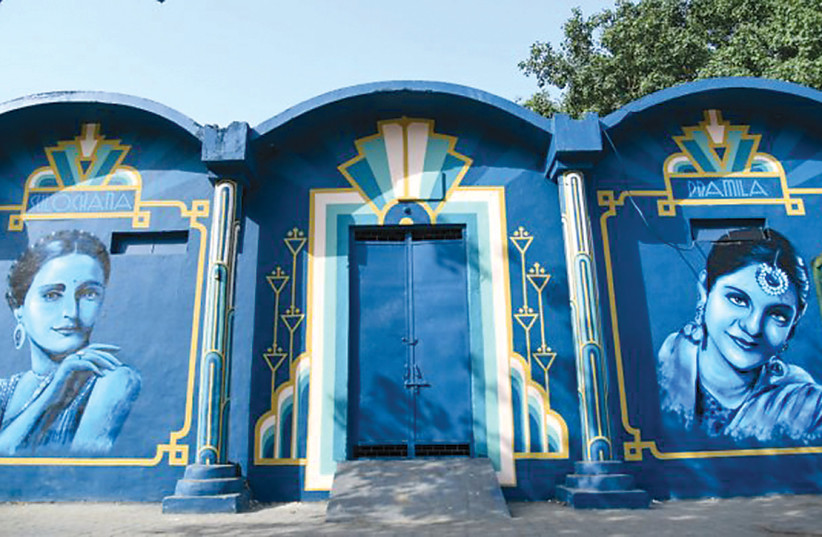Tourists exploring India’s cinematic and Jewish heritage will want to see the recently unveiled mural in New Delhi’s swanky Connaught Place immortalizing silver screen divas Pramila, Sulochana and Nadira. The tribute to the iconic Iraqi-Jewish actresses who shaped Bollywood in the last century was created by the Israel Embassy in India, in collaboration with Delhi Street Art and the New Delhi Municipal Council. Symbolically, it celebrates 30 years of India-Israel diplomatic ties.
For either commercial or ethnic reasons, the three starlets used Hindi stage names. As members of India’s minuscule minority of Mizrachi women, their status was of little consequence in the caste-conscious British Raj. That allowed them to break the taboo against Hindu or Muslim women appearing in movies.
Sulochana – the One With the Beautiful Eyes – née Ruby Myers, an Iraqi-Jewish Bollywood star
Arguably the most beloved Baghdadi superstar was Sulochana – the One With the Beautiful Eyes – née Ruby Myers (1907–1983), who starred in a staggering 72 feature films. The highest-paid actress of India’s silent film era – reportedly better paid than the governor of Bombay, and earning five times more than her male co-star – Sulochana was featured on a 2013 postage stamp as part of a series on Bollywood pioneers.
Born in Pune, Myers worked as a switchboard operator before skyrocketing to fame. Under such legendary directors as Mohan Bhavnani and R. S. Chaudhari, Sulochana performed in silent features including Typist Girl and Wildcat of Bombay. She showed her versatility in the latter by playing eight roles, ranging from a gentleman from the modern Indian city of Hyderabad to a European blonde. Atypically for Anglo-educated Jewish actresses, she made the transition to talkies, most notably Anarkali, although she evidently took a year off to perfect her Hindustani.
Nadira (1932-2006), née Florence Ezekiel: Bollywood's quintessential vamp
The quintessential vamp was Nadira (1932-2006), née Florence Ezekiel from Baghdad, whose family moved to Bombay [today Mumbai] when she was an infant. She starred in the post-independence films of legendary Bollywood producer/director Raj Kapoor including Shree 420 (1955), Pakeezah (1972) and Julie (1975).

Pramila (Esther Victoria Abraham), a rebel from an Iraqi Jewish family
The third of the trio, Esther Victoria Abraham (1916 – 2006), known by her stage name Pramila, was a rebel born to a Calcutta [today Kolkota] Baghdadi family.
Her father, Reuben Abraham, owned O’ Brian and Co., a railway construction firm whose name was anglicized from his own. His Jewish mother had been married to a Hindu, and Abraham’s own first wife was Christian, but after she too died in childbirth, he married 14-year-old Matilda Isaac from the Jewish community in Karachi. Esther Victoria was their eldest daughter. After graduating high school (where she excelled at sports), she taught briefly at Kalkota’s Elias Meyer Free School and Talmud Torah. Pramila starred in scores of hits including Mother India (1938) and Jungle King (1939), and in 1947 won the first Miss India pageant.
All three feature prominently in Danny Ben-Moshe’s 2014 documentary Shalom Bollywood: The Untold Story of Indian Cinema. Ben-Moshe reveals how these Jewish stars pushed the boundaries of Indian cinema, featuring in Bollywood’s first dance, first kiss, first talkie, and first color film.
The mural in Rajiv Chowk – the name given to Connaught Place in 1995 as India removed its colonial symbols – represents the deep-rooted affinity between India and Israel: both ancient countries, each with its own religious-national identity, were occupied by Muslim invaders, colonized by Britain, which hanged freedom fighters in notorious prisons, and gained independence in post-WWII struggles that resulted in mass population transfers.
Designed by British architect Robert Tor Russell as the commercial showpiece of Sir Edwin Lutyens’ grand design for a new imperial city to replace Calcutta, Connaught Place continues to be one of the main financial, business and entertainment centers in the Indian capital.
India and Israel, ties bound by culture, tourism and blood
Cultural ties are only one facet of burgeoning relations between Israel and India. Another is tourism. India beckons newly demobilized IDF veterans with the allure of Goa’s inexpensive shanty beaches, savory curries, and cheap charas. A network of Chabad houses stretches from the Himalayas across the subcontinent offering secular Israeli backpackers a spiritual Jewish experience and a warm Shabbat dinner. Parallel to the post-army trekkers, the 85,000 Indian Jews living in Israel – mainly in Beersheba and Negev moshavim – often visit the old country. Today there are 4,8000 Jews living in India, out of a teeming population of 1.4 billion.
India-Israel ties are also those of blood. As documented in the 2018 action-thriller Hotel Mumbai about the November 26, 2008, attacks by Pakistani jihadists on Mumbai including the landmark Taj Mahal Palace Hotel and the city’s train station, the nearby Chabad House in Colaba was also a terrorist target. The film specifically honors the memory of Chabad-Lubavitch emissaries Rabbi Gavriel Noach (Gabi), 29, and Rivkah (Rivky) Holtzberg, 28, and emphasizes the terrorists’ common anti-Hindu and anti-Jewish ideology.
The blood ties go deeper. Not far from Connaught Place is the Teen Murti Haifa memorial built in New Delhi in 1922, in tribute to the WWI horse-mounted Jodhpur and the Mysore Lancers who four years earlier captured the German machine-gun posts dug into Mount Carmel, thus effectively ending Ottoman control of Palestine.
In enduring testimony to the racism that India and Israel both had to overcome, the colonial troops who fell fighting for His Majesty King George V in Palestine were buried in segregated military cemeteries in Haifa, Ramla and Jerusalem.
Today’s hi-tech arms manufacturers supplying India’s army, navy and air force with sophisticated Israel weapons systems know who their ally is. ■
